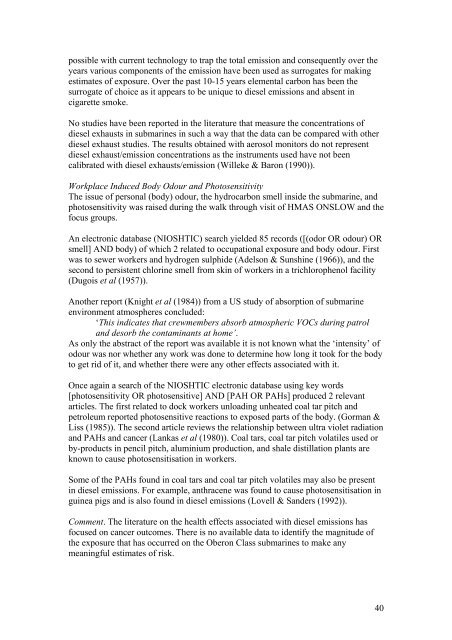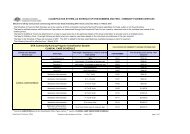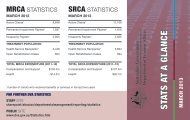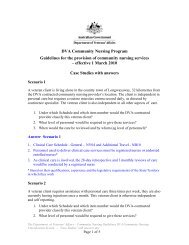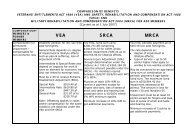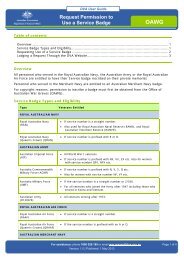Oberon Class Submarine Occupational Hygiene Project Final Report
Oberon Class Submarine Occupational Hygiene Project Final Report
Oberon Class Submarine Occupational Hygiene Project Final Report
Create successful ePaper yourself
Turn your PDF publications into a flip-book with our unique Google optimized e-Paper software.
possible with current technology to trap the total emission and consequently over theyears various components of the emission have been used as surrogates for makingestimates of exposure. Over the past 10-15 years elemental carbon has been thesurrogate of choice as it appears to be unique to diesel emissions and absent incigarette smoke.No studies have been reported in the literature that measure the concentrations ofdiesel exhausts in submarines in such a way that the data can be compared with otherdiesel exhaust studies. The results obtained with aerosol monitors do not representdiesel exhaust/emission concentrations as the instruments used have not beencalibrated with diesel exhausts/emission (Willeke & Baron (1990)).Workplace Induced Body Odour and PhotosensitivityThe issue of personal (body) odour, the hydrocarbon smell inside the submarine, andphotosensitivity was raised during the walk through visit of HMAS ONSLOW and thefocus groups.An electronic database (NIOSHTIC) search yielded 85 records ([(odor OR odour) ORsmell] AND body) of which 2 related to occupational exposure and body odour. Firstwas to sewer workers and hydrogen sulphide (Adelson & Sunshine (1966)), and thesecond to persistent chlorine smell from skin of workers in a trichlorophenol facility(Dugois et al (1957)).Another report (Knight et al (1984)) from a US study of absorption of submarineenvironment atmospheres concluded:‘This indicates that crewmembers absorb atmospheric VOCs during patroland desorb the contaminants at home’.As only the abstract of the report was available it is not known what the ‘intensity’ ofodour was nor whether any work was done to determine how long it took for the bodyto get rid of it, and whether there were any other effects associated with it.Once again a search of the NIOSHTIC electronic database using key words[photosensitivity OR photosensitive] AND [PAH OR PAHs] produced 2 relevantarticles. The first related to dock workers unloading unheated coal tar pitch andpetroleum reported photosensitive reactions to exposed parts of the body. (Gorman &Liss (1985)). The second article reviews the relationship between ultra violet radiationand PAHs and cancer (Lankas et al (1980)). Coal tars, coal tar pitch volatiles used orby-products in pencil pitch, aluminium production, and shale distillation plants areknown to cause photosensitisation in workers.Some of the PAHs found in coal tars and coal tar pitch volatiles may also be presentin diesel emissions. For example, anthracene was found to cause photosensitisation inguinea pigs and is also found in diesel emissions (Lovell & Sanders (1992)).Comment. The literature on the health effects associated with diesel emissions hasfocused on cancer outcomes. There is no available data to identify the magnitude ofthe exposure that has occurred on the <strong>Oberon</strong> <strong>Class</strong> submarines to make anymeaningful estimates of risk.40


